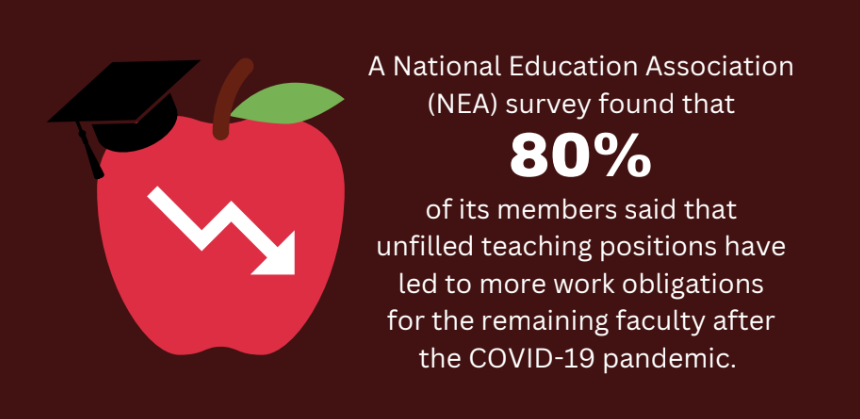Freedom should hire more teachers
Adding more teachers would alleviate stress, expand class selection
Everyone has heard of the classic game, Jenga. In Jenga, players meticulously pull wooden blocks one by one out of a tower. Eventually, players remove too many blocks, and the tower crashes to the floor. This principle can be applied to visualizing the effects of not having enough teachers. Each time a teacher retires or leaves the district, that tower becomes slightly less stable, unless another block is added. Taking out too many blocks causes not only stress for the remaining staff, but for students as well. This explains why Freedom should consider hiring two to three more educators.
Looking at the numbers at first glance, one would assume there’s really no need to expand the staff. The high school has 32 teachers, compared with the student population of 410; this produces a student-to-teacher ratio of about 13:1. This ratio does sound reasonable, until one looks at the number of teachers per department.
In several vital subjects, there are only four teachers per department like science, math and social studies. Essentially, this leaves one teacher to teach each grade level. Because of this, a teacher’s workload can become rigid and inflexible. For example, Ms. Maria Porter teaches the entire freshman class through her U.S. History II course.
“I do a lot of work at home, like after my kids go to bed or on the weekends. I will work all night on creating things, making slide decks or building tests,” Porter said.
This inflexibility becomes less of an issue when adding more educators, especially since there could be more classes for students to take. Hiring more teachers would introduce key, influential topics in courses the high school currently does not have. For example, hiring another math teacher could lead to a statistics or accounting
course. This could also lead to more advancement or inclusion classes. By ignoring the need to expand the number of educators, the district is limiting the scope and future possibilities of students.
“When I started here, there were five [teachers in the social studies department], and now we are at four,” Mr. Nathaniel Langelli said. “And with that, we became more limited in the number of course selections available for students.”
Furthermore, teachers are already operating at their max capacity, but they still support giving students more opportunities. However, adding new classes with a limited staff becomes unreasonable when teachers are already doing so much. It’s almost as if teachers are drowning in a sea of work and lesson plans. Instead of throwing a much needed life jacket, the district tosses them an anchor. Teachers’ workload and working environment has caused a nationwide shortage. In fact, according to the PA Department of Education, there has been a 66% drop of Instructional 1 teaching certificates issued between the 2012-13 and 2020-21 school years.
Due to a lack of educators, students, like junior Dylan Scheel, have run out of classes to take. Having taken AP Calculus as a sophomore, there were no other face-to-face math courses available for Scheel at Freedom. Not wanting to skip out on two years of math, Scheel moved to North Catholic in the middle of last school year.
“I never wanted to leave Freedom. But, when it came down to having no classes left to take, it was a no-brainer that change was needed,” Scheel said.
Not only would students have more opportunities to explore their interests, but scheduling would open up and become more flexible as well. Students could take the classes they want and not be told that a class “does not fit” into their schedules.
Of course, there are some key opposing arguments to this change. We are a small school district, and hiring more educators does cost money. However, there comes a time when we have to ask ourselves, “What’s more important: the future generations’ education or money?”
Simply put, school officials are asking more of teachers when they are given less. Being restricted in the amount of classes one can teach causes an apprehensive, limiting environment for both students and staff. The addition does not have to be monumental; even adding one more teacher can positively impact the school. But, something needs to be done before that tower collapses.
“It doesn’t have to be that we are adding 20 new teachers; two or three people can make a huge difference in what we offer. It would just alleviate stress for everybody,” Porter said.
frequent in sports that many may wonder if sports really mean that much. Although sports may be fun to watch it may not always be worth it.



